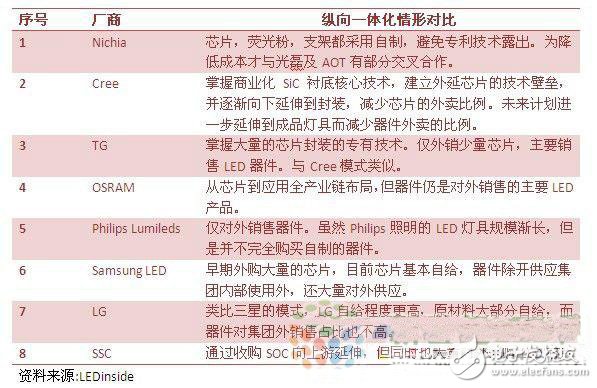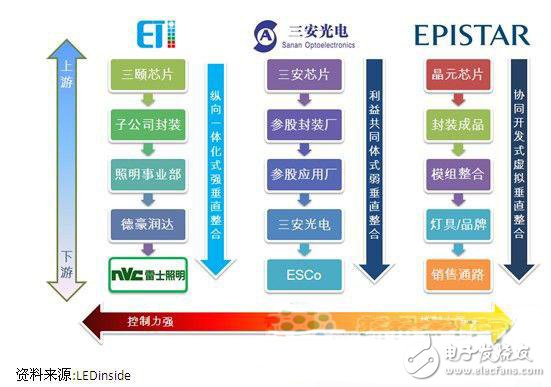Looking at the global LED industry, the five major manufacturers plus the three major Korean manufacturers have basically adopted a strategy of vertical integration, but to varying degrees.
Self-made or outsourcing, self-use or take-out, it seems that two simple business decisions are related to an important strategy of an enterprise, that is, whether to implement vertical integration.
According to the definition of economics, vertical integration is also called vertical integration. It refers to the strategic form in which an enterprise combines production and raw material supply, or production and product sales. It is an enterprise that expands its existing business in two possible directions. A development strategy is a strategic system that extends the company's operating activities backward to the supply of raw materials or forward to the sales terminal. The purpose is to strengthen the core enterprise's control over the entire process of raw material supply, product manufacturing, distribution and sales, so that the enterprise can take the initiative in market competition, so as to increase the profit of each business activity stage and the overall competitiveness of the enterprise.
Global LED manufacturers vertical integration strategy
Looking at the global LED industry, the five major manufacturers plus the three major Korean manufacturers have basically adopted a strategy of vertical integration, but to varying degrees.

The reason why the above-mentioned enterprises can implement vertical integration is because these giants themselves have strong downstream entry points, and the downstream packaging capacity is enough to support the epitaxial chip business to enjoy obvious economies of scale. There are a large number of patents and proprietary technologies on the chip epitaxy. Therefore, it is more inclined to produce their own chips to avoid the leakage of proprietary technologies and private information. However, even the aforementioned large international companies rarely have pure vertical integration. Even though most enterprises extend to more than one link in the layout of the industrial chain, they still purchase or sell some intermediate products. Therefore, most of their models still belong to progressive integration (tapered integraTIon).
Textbooks on the advantages and disadvantages of progressive integration will be explained, and this article will not expand. However, what is certain is that when LED application products gradually mature, the scale of downstream application markets grows, and the self-operated LED application product business is sufficient to support the capacity required by the economies of scale in the upstream and midstream, major international manufacturers will inevitably tend to reduce chips or The proportion of external sales of intermediate products such as devices.
Downstream LED lighting market volume, cross-strait LED industry vertical fermentation conditions gradually ferment
Compared with the above-mentioned international manufacturers, LED companies on both sides of the strait not only lost their patents, but also at the beginning stage, because of their small scale, no one has the strength and scale to complete the vertical integration of the entire industrial chain, so naturally chose marketization Ways to develop themselves, each company tries its best to focus limited resources on the operation of a certain link in the industry chain. Therefore, it has created the world's largest specialized market for the LED industry. Although it suffers from the disadvantage of high transaction costs compared to vertical integration, each surviving company can also achieve the largest degree of economies of scale in its own business field. The fierce market competition has also made LED companies on both sides of the strait full of vitality and stimulated full entrepreneurship and innovation.
However, LEDinside estimates that by 2015, the actual demand for LED general lighting in China will reach 67.8 billion yuan. As the economy continues to grow and LED penetration increases, it will reach RMB 138.6 billion by 2020. When the scale of China's LED industry is gradually growing, and the vigorous development of the downstream LED lighting market can gradually support more large enterprises, for Chinese LED companies, the reasons for implementing a vertical integration strategy are also more adequate: Upstream production capacity achieves economies of scale, exempts transaction costs, and costs are better than outsourcing; it can use low-cost strategies to seize the market upstream and downstream; shorten new product development processes and the rapid application of the latest advantageous technologies; avoid the outflow of core technologies and operating information; Subject to upstream key material suppliers, etc.
In fact, LEDinside has observed that many companies on both sides of the strait are working in this direction. However, most of them can only extend from packaging to applications, some from applications to packaging, and a few from packaging to epitaxial chips, but more typical It belongs to Jingdian, Sanan and Dehao Runda, because their influence on the industry is more important. How they can achieve vertical integration through different ways and complete the layout from epitaxial chips to packaging and applications is worthy of our analysis and thinking.
Jingdian, Sanan, Dehao Runda's vertical integration strategy comparison

Viewed separately, DHL Runda has focused on the vertical integration of the entire industrial chain since it entered the LED industry. Through the acquisition and integration of a series of upstream and downstream companies and management teams in the industrial chain, China-Taiwan investment Among the LED companies, the industry chain has the deepest footsteps and the largest vertical span. The acquisition of NVC and Valmet's shares has pushed the value chain into channels and mass marketing.
However, the problem faced by DHL Runda was that the different industrial chain links of the entire company were strongly and artificially integrated together, but upstream and downstream did not cooperate smoothly. The business units of each link are purchased and sold by themselves, and the advantages of the upstream and downstream have not formed an effective joint force. While taking advantage of NVC's internal power struggles to obtain NVC's controlling stake at a lower cost, controlling the channels of NVC is a coup that may bring the Dehaorunda system to life in one step. With NVC's huge estuary, DHL Runda has the opportunity to successfully open up its own internal links between various links, and use the huge downstream orders to drive the release of upstream production capacity and achieve economies of scale in all links of the industrial chain, so as to achieve a total The lowest cost goal.
On the other hand, looking at Sanan, the previous positioning has been a chip factory. Although it has obtained a large number of orders for finished lamps and lanterns with local governments through market exchange investment, and gradually established a relatively large-scale application department, but chips are still the main business of the entire company. In the case where low-end and middle-end chips are generally homogenized and chip companies are forced to use price wars as their main means of competition, Sanan's situation is that Taiwan has been surrounded before, and domestic investment has followed. In order to ensure the stable demand, Sanan Optoelectronics must also have a huge downstream estuary. Therefore, Sanan is also actively establishing a community of interests through a series of methods such as equity investment to form a weakly integrated vertical integration system.
And Jingdian's virtual vertical integration is still a market-oriented resource allocation method. For downstream partners, Jingdian uses its own development capabilities to provide assistance. This kind of collaborative development can run through the entire industrial chain, from chips, packages, modules, to final products and even brands and channels, all of which can utilize Jingdian's rich industrial knowledge, precise insights and innovative production technologies. The benefits of virtual vertical cooperation are very obvious, in fact, it is to strengthen cooperation between upstream and downstream while maintaining the necessary openness. This is different from full marketization. Through this cooperation, Jingdian can provide value-added services to downstream partners and help customers succeed to maintain customer loyalty. The growth of customers in turn brought more orders for Jingdian. At the same time, there can be more than one such customer, ensuring a certain number of similar customers will keep Jingdian always in a safe position in the industry chain.
However, the binding power of such integration is conceivably weak. Jingdian mainly can rely on its own research and development capabilities, technical capabilities and other unconstrained influence to maintain the loyalty of partners. And this ability-based attraction may not be as reliable as finding partners with shared values. Because in a dynamic market, through the learning effect, capabilities can be transferred, and the comparison of capabilities can be transformed.
No one strategy can be applied to all enterprises and all environments. The right strategy is the best strategy. The three vertical integration modes of Sanan Optoelectronics, Dehao Runda and Epistar Optoelectronics have their own characteristics. It is better to say which one is better, but it provides three alternative reference cases for vertical integration. In the future, there will still be Ruifeng Optoelectronics, Jufei Optoelectronics, which focuses on packaging, as well as Huacan Optoelectronics, Qianzhao Optoelectronics, which specializes in chips, and National Star Optoelectronics, which constantly tries to extend upstream and downstream , Silanwei. The same business environment has such a completely different strategic model. This is the best opportunity for trial and error prepared by the Chinese LED industry for the great companies in the future.
General specifications
Base speed: 2 Detachable shaft: lock & unlock sign
LED light: No Speed setting: 10
Technical specifications
Power: 200W/250W/300W Frequency: 50/60 Hz
Voltage: 220-240V Cord length: 1.2 m
Design specifications
Material body: ABS Surface finishing: injected color
Material rod: Stainless steel Material blade: Stainless steel
Material measure cup & chopper: SAN
Dishwasher attachments: Yes
Approvals
GS/CE/CB/LVD/EMC/ROHS/LFGB/DGCCRF/REACH/ERP
Optional Accessories
A. Mixer Beater (s/s)
B. Mixer whisk (s/s)
C. Potato masher
D.550ml measure cup
F. 700ml measure cup
G.350ml chopper
H.700ml Chopper with non-slip base
I. Fine slicer & Julienne Disc, Rough slicer & Julienne Disc, Shred Disc.(For 700ml chopper use only)
K. Wall mounting
L. Bracket

3-In-1 Twisting Handheld Mixer,Hand Food Mixer ,Cordless Mixer With Stand,Mini Hand Mixer Blender
Housoen Electric Manufacture Co., Ltd. , https://www.housoenappliances.com